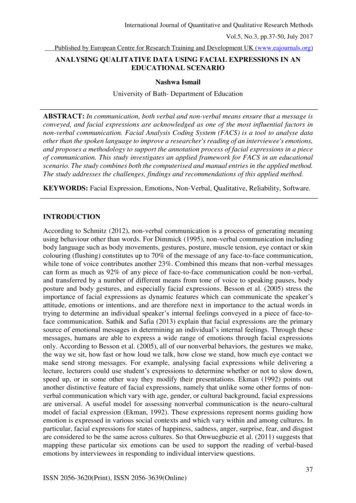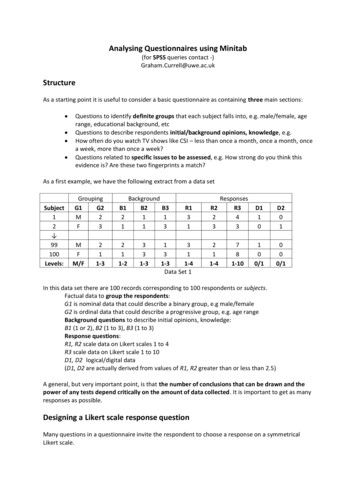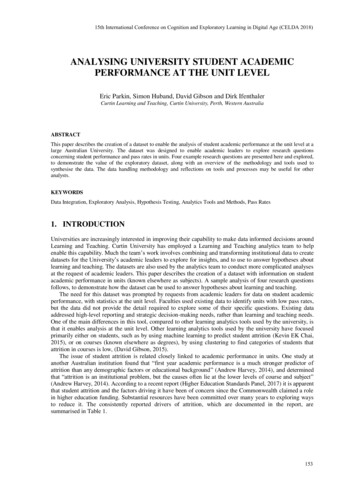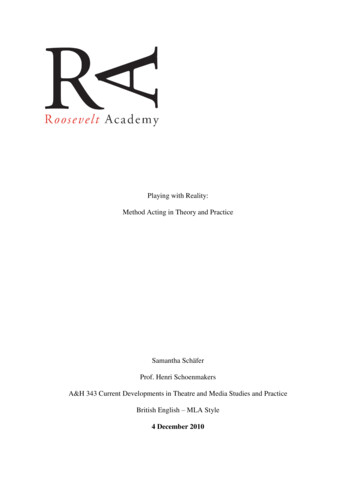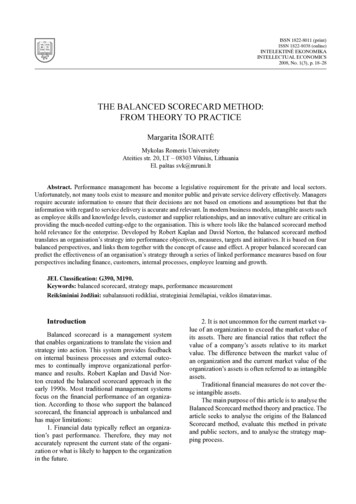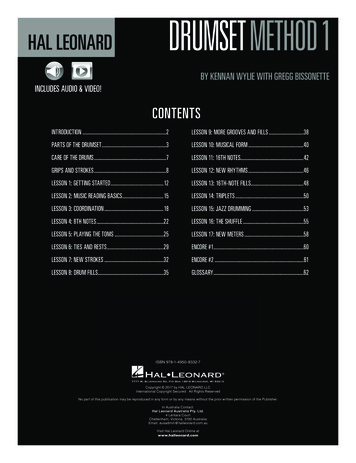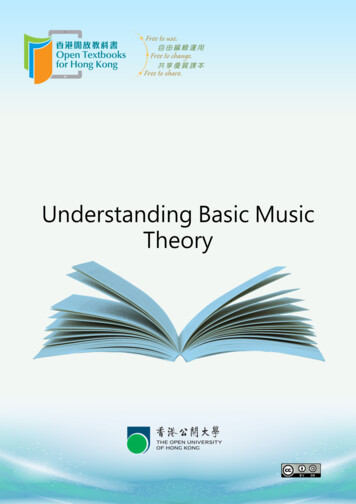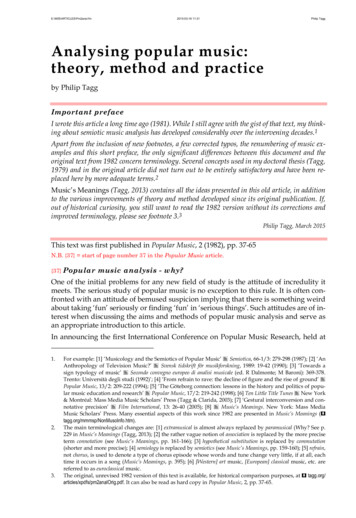
Transcription
E:\M55\ARTICLES\Pm2anal.fm2015-03-16 11:31Philip TaggAnalysing popular music:theory, method and practiceby Philip TaggImportant prefaceI wrote this article a long time ago (1981). While I still agree with the gist of that text, my thinking about semiotic music analysis has developed considerably over the intervening decades.1Apart from the inclusion of new footnotes, a few corrected typos, the renumbering of music examples and this short preface, the only significant differences between this document and theoriginal text from 1982 concern terminology. Several concepts used in my doctoral thesis (Tagg,1979) and in the original article did not turn out to be entirely satisfactory and have been replaced here by more adequate terms.2Music’s Meanings (Tagg, 2013) contains all the ideas presented in this old article, in additionto the various improvements of theory and method developed since its original publication. If,out of historical curiosity, you still want to read the 1982 version without its corrections andimproved terminology, please see footnote 3.3Philip Tagg, March 2015This text was first published in Popular Music, 2 (1982), pp. 37-65N.B. {37} start of page number 37 in the Popular Music article.{37} Popularmusic analysis - why?One of the initial problems for any new field of study is the attitude of incredulity itmeets. The serious study of popular music is no exception to this rule. It is often confronted with an attitude of bemused suspicion implying that there is something weirdabout taking ‘fun’ seriously or finding ‘fun’ in ‘serious things’. Such attitudes are of interest when discussing the aims and methods of popular music analysis and serve asan appropriate introduction to this article.In announcing the first International Conference on Popular Music Research, held at1.2.3.For example: [1] ‘Musicology and the Semiotics of Popular Music’ b Semiotica, 66-1/3: 279-298 (1987); [2] ‘AnAnthropology of Television Music?’ b Svensk tidskrift för musikforskning, 1989: 19-42 (1990); [3] ‘Towards asign typology of music’ b Secondo convegno europeo di analisi musicale (ed. R Dalmonte; M Baroni): 369-378.Trento: Università degli studi (1992)’; [4] ‘From refrain to rave: the decline of figure and the rise of ground’ bPopular Music, 13/2: 209-222 (1994); [5] ‘The Göteborg connection: lessons in the history and politics of popular music education and research’ b Popular Music, 17/2: 219-242 (1998); [6] Ten Little Title Tunes b New York& Montréal: Mass Media Music Scholars’ Press (Tagg & Clarida, 2003); [7] ‘Gestural interconversion and connotative precision’ b Film International, 13: 26-40 (2005); [8] b Music’s Meanings. New York: Mass MediaMusic Scholars’ Press. Many essential aspects of this work since 1982 are presented in Music’s Meanings (tagg.org/mmmsp/NonMusoInfo.htm).The main terminological changes are: [1] extramusical is almost always replaced by paramusical (Why? See p.229 in Music’s Meanings (Tagg, 2013); [2] the rather vague notion of association is replaced by the more preciseterm connotation (see Music’s Meanings, pp. 161-166); [3] hypothetical substitution is replaced by commutation(shorter and more precise); [4] semiology is replaced by semiotics (see Music’s Meanings, pp. 159-160); [5] refrain,not chorus, is used to denote a type of chorus episode whose words and tune change very little, if at all, eachtime it occurs in a song (Music’s Meanings, p. 395); [6] [Western] art music, [European] classical music, etc. arereferred to as euroclassical music.The original, unrevised 1982 version of this text is available, for historical comparison purposes, at tagg.org/articles/xpdfs/pm2analOrig.pdf. It can also be read as hard copy in Popular Music, 2, pp. 37-65.
2P Tagg: Analysing Popular Music (1982, minor revisions 2015)Amsterdam in June 1981, The Times Diary printed the headline ‘Going Dutch - The Donnish Disciples of Pop’ (The Times 16 June 1981). Judging from the generous use of inverted commas, sics and ‘would-you-believe-it’ turns of phrase, the Times diarist wascomically baffled by the idea of people getting together for some serious discussionsabout a phenomenon which the average Westerner’s brain probably spends aroundtwenty-five per cent of its lifetime registering, monitoring and decoding. It should beadded that The Times is just as incredulous about ‘”A Yearbook of Popular Music”(sic)’ (their sic), in which this ‘serious’ article about ‘fun’ now appears.In announcing the same conference on popular music research, the New Musical Express(20 June 1981, p. 63) was so witty and snappy that the excerpt can be quoted in full.Meanwhile, over in Amsterdam this weekend, high foreheads from the four corners of theearth (Sid and Doris Bonkers) will meet for the first International Conference on Popular Music at the University of Amsterdam. In between the cheese and wine parties, serious youngmen and women with goatee beards and glasses will discuss such vitally important issues as‘God, Morality and Meaning in the Recent Songs of Bob Dylan’.4 Should be a barrel oflaughs.This imaginative piece of poetry is itself a great barrel of laughs to anyone present atthe conference with its zero (0 per cent) wine and cheese parties, one (0.8 per cent) goatee beard and a dozen {38} (10 per cent) bespectacled participants. (As ‘Sid Bonkers’, I doadmit to having worn contact lenses). Talks were given by active rock musicians, by anex-NME and Rolling Stone journalist, by radio people and by Paul Oliver, who mayhave worn glasses but who, even if maliciously imagined with a goatee beard, hornsand a trident, has probably done more to increase respect, understanding and enthusiasm for the music of black Americans than the NME is ever likely to.This convergence of opinion between such unlikely bedfellows as The Times and theNME about the imagined incongruity of popular music as an area for serious study implies one of two things. Either popular music is so worthless that it should not be takenseriously (unlikely, since pop journalists obviously rely on the existence of popular music for their livelihood) or academics are so hopeless — absent-mindedly mumblinglong Latin words under their mortarboards in ivory towers — that the prospect of themtrying to deal with anything as important as popular music is just as absurd. However,The Times and NME are not alone in questioning the ability of traditional scholarship todeal with popular music. Here they join forces with no mean number of intellectualmusicians and musically interested academics.Bearing in mind the ubiquity of music in industrialised capitalist society, its importanceat both national and transnational levels (see Varis 1975, Chapple and Garofalo 1977,Frith 1978, Fonogrammen i kulturpolitiken 1979) and the share of popular music in all this,the incredible thing is not that academics should start taking the subject seriously butthat they have taken such a time getting round to it. Until recently, publicly funded musicology has passively ignored the sociocultural challenge of trying to inform therecord-buying, Muzak-registering, TV watching and video-consuming public ‘whyand how who’ (from the private sector) ‘is communicating what to whom’ (in the public sector) ‘and with what effect’ (apologies to C S Peirce). Even now it does very little.Nevertheless, to view the academic world as being full of static and eternal ivory towerstereotypes is to reveal an ahistorical and strangely defeatist acceptance of the schizophrenic status quo in capitalist society. It implies atomisation, compartmentalisationand polarisation of the affective and the cognitive, of private and public, individual andcollective, implicit and explicit, entertaining and worrying, fun and serious, etc. The4.No such talk was on the conference programme! Actually it is the title of Wilfrid Mellers’s article in PopularMusic 1 (1981, pp. 143-157).
P Tagg: Analysing Popular Music (1982, minor revisions 2015)3‘never-the-twain-shall-meet’ syndrome is totally untenable in the field of popular music (or the arts in general). You don’t have to be a don to understand that there are objective developments in nineteenth- and twentieth-century music history whichdemand that changes be made, not leas in academic circles.These developments can be summarised as follows: (1) a vast increase in the sharemusic takes in the money and time budgets of citizens in the industrialised world; (2)shifts in class structure leading to the advent of socioculturally definable groups, suchas young people in student or unemployment limbo between childhood and adulthood, and their need for collective identity; (3) technological advances leading to thedevelopment of recording techniques capable (for the first time in history) of accuratelystoring and allowing for mass distribution of non-written musics; (3) transistorisation,microelectronics and all that such advances mean to the mass dissemination of music;(5) the development of new musical functions in the audiovisual media (for example,films, TV, video, advertising); (6) the ‘non-communication’ crisis in modern Westernart music and the stagnation of official art music in historical moulds; (7) the development of a loud, permanent, mechanical lo-fi soundscape (Schafer 1974, 1977) and its ‘reflection’ (Riethmüller 1976) in electrified music with regular pulse (Bradley 1980); (8)the general acceptance of certain Euro- and Afro-American genres as constituting a lingua franca of musical expression in a large number of contexts within industrialised society; (9) the gradual, historically inevitable replacement of intellectuals schooled solelyin the euroclassical tradition by others exposed to the same tradition but at the sametime brought up on Presley, the Beatles and the Stones.{39}To those of us who during the fifties and sixties played both Scarlatti and soul, did palaeography and Palestrina crosswords as well as working in steelworks, and whowalked across quads on our way to the ‘Palais’ or the pop club, the serious study ofpopular music is not a matter of intellectuals turning hip or of mods and rockers goingacademic. It is a question of (a) getting together two equally important parts of experience, the intellectual and emotional, inside our own heads and (b) being able as musicteachers to face pupils whose musical outlook has been crippled by those who present‘serious music’ as if it could never be ‘fun’ and ‘fun music’ as though it could neverhave any serious implications.It’s in this light that the serious study of popular music becomes obvious, while the casefor making it a laughing matter, although understandable (it can be hilarious at times),is basically reactionary and will be dispensed with for the rest of this article. This is because the aim of what follows is to present a musicological model for tackling problemsof popular music content analysis. It is hoped that this might be of some use to musicteachers, musicians and others looking for a contribution towards the understandingof ‘why and how does who communicate what to whom and with what effect’. {40}Musicology and popular music researchStudying popular music is an interdisciplinary matter. Musicology still lags behindother disciplines in the field, especially sociology. The musicologist is thus at a simultaneous disadvantage and advantage. The advantage is that he/she can draw on sociological research to give the analysis proper perspective. Indeed, it should be stated atthe outset that no analysis of musical discourse can be considered complete withoutconsideration of social, psychological, visual, gestural, ritual, technical, historical, economic and linguistic aspects relevant to the genre, function, style, (re-)performance situation and listening attitude connected with the sound event being studied. Thedisadvantage is that musicological ‘content analysis’ in the field of popular music isstill an underdeveloped area and something of a missing link (see Schuler 1978).
4P Tagg: Analysing Popular Music (1982, minor revisions 2015)Music analysis and the communication processLet us assume music to be that form of interhuman communication in which individually experienceable affective states and processes are conceived and transmitted as humanly organised nonverbal sound structures to those capable of decoding theirmessage in the form of adequate affective and associative response (Tagg 1981b). Letus also assume that music, as can be seen in its modes of ‘performance’ and reception,most frequently requires by its very nature a group of individuals to communicate either among themselves or with another group; thus most music (and dance) has an intrinsically collective character not shared by the visual and verbal arts. This shouldmean that music is capable of transmitting the affective identities, attitudes and behavioural patterns of socially definable groups, a phenomenon observed in studies of subcultures and use by US-American format radio to determine advertising markets(Karshner 1971).Now, although we have considerable insight into socioeconomic, subcultural and psychosocial mechanisms influencing the ‘emitter’ (by means of biographies, etc.) and ‘receiver’ of certain types of popular music, we have very little explicit information aboutthe ‘channel’, about ‘the music itself’. We know very little about its ‘signifiers’ and ‘signifieds’, about the relations the music establishes between emitter and receiver, abouthow a musical message actually relates to the set of affective and connotative conceptspresumably shared by emitter and receiver, and how it interacts with their respectivecultural, social and natural environments. In other words, reverting to the question‘why and how does who say what to whom and with what effect?’, we could {41} saythat sociology answers the questions ‘who’, ‘to whom’ and, with some help from psychology, ‘with what effect’ and possibly parts of ‘why’, but when it comes to the rest of‘why’
2 P Tagg: Analysing Popular Music (1982, minor revisions 2015) Amsterdam in June 1981, The Times Diary printed the headline ‘Going Dutch - The Don- nish Disciples of Pop’ (The Times 16 June 1981).Judging from the generous use of in-verted commas, sics and ‘would-you-believe-it’ turns of phrase, the Times diarist was comically baffled by the idea of people getting together for some .


